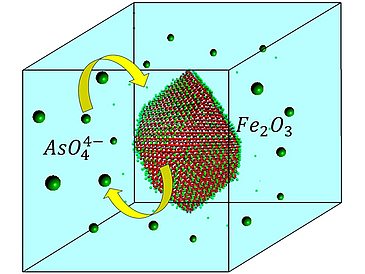Inna Kurganskaya, Nabeel Khan Niazi, Andreas Luttge
Journal of Hazardous Materials (2021) 417, 5
https://doi.org/10.1016/j.jhazmat.2021.126005
The era of advanced computer simulations in materials science enables a great potential to design in silico computational experiments for (nano-)material performance. The adsorption efficiency of nanoparticles in various environments can be unveiled by atomistic models and computer simulations. Arsenic (As) is one of the important globally distributed contaminants with a hazardous impact on human health and environment, and it can strongly bind with iron nanocrystals (e.g., hematite (Fe2O3)) depending on their shape and size. Here, we developed a novel Kinetic Monte Carlo (KMC) model capable of exploring and delineating shape-efficiency dependence for Fe2O3 nanocrystals in contact with arsenate-contaminated water. This newly designed model demonstrated the performance of nanocrystals for removal of toxic (As) ions on their surface. The current model opens new avenues for designing further advanced KMC models for nanoparticles-toxic ions interactions, under varying environmentally relevant situations, e.g., groundwater, wetlands, and water treatment systems. In addition to bidentate adsorption complexes, implemented in the model presented, monodentate and outer-sphere adsorption complexes should be incorporated into the KMC model. Detailed environmental controls can be addressed by implementation of pH and background ions.
© The Authors, https://doi.org/10.1016/j.jhazmat.2021.126005, licensed under CC BY-NC-ND 4.0


